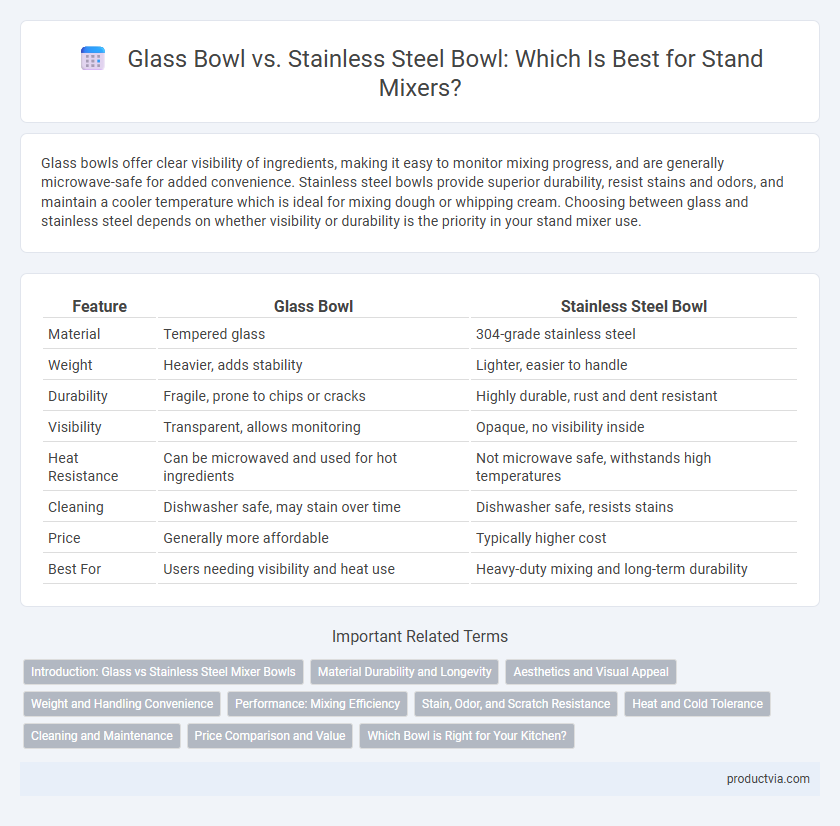Glass bowls offer clear visibility of ingredients, making it easy to monitor mixing progress, and are generally microwave-safe for added convenience. Stainless steel bowls provide superior durability, resist stains and odors, and maintain a cooler temperature which is ideal for mixing dough or whipping cream. Choosing between glass and stainless steel depends on whether visibility or durability is the priority in your stand mixer use.
Table of Comparison
| Feature | Glass Bowl | Stainless Steel Bowl |
|---|---|---|
| Material | Tempered glass | 304-grade stainless steel |
| Weight | Heavier, adds stability | Lighter, easier to handle |
| Durability | Fragile, prone to chips or cracks | Highly durable, rust and dent resistant |
| Visibility | Transparent, allows monitoring | Opaque, no visibility inside |
| Heat Resistance | Can be microwaved and used for hot ingredients | Not microwave safe, withstands high temperatures |
| Cleaning | Dishwasher safe, may stain over time | Dishwasher safe, resists stains |
| Price | Generally more affordable | Typically higher cost |
| Best For | Users needing visibility and heat use | Heavy-duty mixing and long-term durability |
Introduction: Glass vs Stainless Steel Mixer Bowls
Glass mixer bowls offer the advantage of being transparent, allowing users to monitor the mixing process easily without stopping the machine, while providing non-reactive and stain-resistant properties ideal for acidic ingredients. Stainless steel bowls are favored for their durability, lightweight design, and excellent heat conduction, which is beneficial for recipes requiring temperature control. Both materials are dishwasher safe but vary in impact resistance, with stainless steel being more resistant to dents and breaks compared to glass.
Material Durability and Longevity
Glass bowls for stand mixers offer excellent resistance to staining and odor retention, maintaining clarity and a sleek appearance over time without rusting or corroding. Stainless steel bowls provide superior durability against impacts, dents, and scratches, ensuring long-lasting performance even with frequent use in commercial or heavy-duty environments. Both materials contribute to the longevity of stand mixers, but stainless steel is generally preferred for its enhanced toughness and resistance to wear over prolonged periods.
Aesthetics and Visual Appeal
Glass bowls for stand mixers offer a clear, elegant appearance that allows users to monitor mixing progress visually, enhancing the kitchen's aesthetic with a modern, clean look. Stainless steel bowls provide a sleek, professional finish with a polished or brushed surface that resists stains and maintains a timeless, durable appeal. Both materials contribute distinct visual elements, with glass emphasizing transparency and lightness, while stainless steel showcases strength and sophistication.
Weight and Handling Convenience
Glass bowls for stand mixers offer the benefit of transparency, allowing users to monitor mixing progress easily, but they tend to be heavier and more fragile compared to stainless steel bowls. Stainless steel bowls are significantly lighter, enhancing handling convenience and reducing user fatigue during mixing tasks. The durable nature of stainless steel also provides greater resistance to impact and easier maneuverability, making it a preferred choice for frequent use and heavy-duty mixing.
Performance: Mixing Efficiency
Glass bowls allow users to monitor mixing progress visually, ensuring thorough ingredient incorporation during recipes. Stainless steel bowls offer superior durability and better temperature control, which enhances mixing efficiency, especially for dough and heavy batters. The choice between glass and stainless steel impacts overall mixing performance based on recipe requirements and user preference for visibility versus temperature stability.
Stain, Odor, and Scratch Resistance
Glass bowls for stand mixers offer excellent stain and odor resistance due to their non-porous surface, preventing absorption of food colors and smells. Stainless steel bowls provide superior scratch resistance and durability, making them ideal for heavy-duty mixing tasks without worrying about surface damage. Both materials are dishwasher safe, but stainless steel excels in resisting stains over time, while glass bowls maintain clarity and are less susceptible to odor retention.
Heat and Cold Tolerance
Glass bowls for stand mixers excel in heat and cold tolerance, remaining stable under temperature extremes and ideal for recipes requiring temperature control, such as whipping cream or chilling dough. Stainless steel bowls offer superior durability and rapid temperature adjustment but may conduct heat or cold faster, affecting delicate mixtures. Choosing between glass and stainless steel depends on the specific baking or cooking technique and temperature sensitivity required for optimal results.
Cleaning and Maintenance
Glass bowls for stand mixers offer the advantage of being dishwasher safe and non-porous, which prevents odor retention and makes cleaning straightforward. Stainless steel bowls, while also easy to clean, may require hand washing to maintain their polished finish and avoid water spots. Both materials are durable, but glass bowls provide better visibility of ingredients during mixing, whereas stainless steel bowls are generally lighter and more resistant to breaking.
Price Comparison and Value
Glass bowls for stand mixers typically cost more upfront but offer the advantage of visibility and microwave safety, providing added value for users prioritizing convenience and versatility. Stainless steel bowls are generally more affordable and durable, making them the preferred choice for heavy-duty mixing and long-term use due to their resistance to scratches and stains. The price difference reflects the material benefits, with glass bowls suitable for occasional home use and stainless steel bowls delivering better value for frequent, intensive mixing tasks.
Which Bowl is Right for Your Kitchen?
Glass bowls for stand mixers provide the advantage of visibility, allowing you to monitor mixing progress without stopping the machine, and they resist staining and odor retention. Stainless steel bowls offer superior durability, excellent heat conduction for recipes requiring temperature control, and are generally lighter, making them easier to handle. Choosing between glass and stainless steel bowls depends on your priority for visual monitoring versus robustness and weight in your kitchen tasks.
Glass bowl vs Stainless steel bowl for stand mixers Infographic

 productvia.com
productvia.com